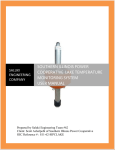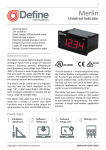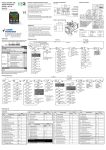Download Introduction to Technological Systems Project
Transcript
IAT 267 Final Project Sec D100 Climate Control System Fan Group Members: Nazanine Helmi(301075194), Rodrigo Ortega (301068553), Alannah Darnel (301087087), Shayan Aryanpour (301066746) For our project we wanted to create a system that would be efficient and easy to use for users, as well as an environmentally friendly system that would reduce the energy consumption levels. The system we created would be denominated as a "Climate Control System" (CCS), which would make use of two different sensors to control the functionality and performance of the whole system. The system will have an automatic on/off function that will allow less energy consumption. This will be controlled by the light sensor, which whenever light is sensed, then the whole system will turn ON, whereas when the sensor doesn't detect any light, the system will be OFF, assuming that a dark room will represent an empty room and a lit room will represent that there is people in the room. The temperature sensor will be the device that will control the actual fan speed. The speed of the fan will be directly proportional to the temperature reading. The way it will work is that the higher the temperature reading (warmer climate), the faster the speed of the fan, thus cooling down the environment. If the temperature is a lower reading, the fan will not move as quickly or turn on. This climate control system's main goal is to control the energy consumption levels of the user. By controlling the system powering on and off in order to achieve the most suitable climate, the whole idea of saving energy is totally achieved. Some commercial and even industrial fans nowadays have a feature of either warming up or cooling down a climate controlled area, and they are often not designed to be energy efficient. Our system's commercial and/or industrial application and goal is this, control and reduce at a minimum the energy consumption levels. Some possible applications for a climate control product such as this can include being used in classrooms, offices, and public transportation systems to save energy. Similar systems are already used to control the temperature of electronic systems. Take a laptop fan that keeps the computer cool for example. Without, the CPU would get too hot and fail to function properly or not work at all. As mentioned above, our Climate Control System consists of two sensors – a light sensor and a temperature sensor. Other hardware included in this system includes an arduino board, wires, solder less breadboard, a power source (USB cord in the computer USB port in the photos), and lastly the processing code. The first step we had to do was research. What kind of sensors would work best for our idea? How would we have to change our idea around in order for us to maximize the efficiency of the final product? How much knowledge of arduino coding do we need? In the beginning when we were still processing project ideas, we had to take these things into consideration. After much iteration, we finally came up with the idea to design something that would not only show off our knowledge of sensors and circuitry, but also be able to serve a purpose in the world such as climate control and energy saving. The first thing we did after we finalized our idea was gather all the equipment. The arduino board, wires, and sensors were available to us from the school library. On the other hand, we had to purchase a compatible fan from an electronic store separately. Fan for our circuit Arduino & USB Collaborating The next thing we had to do after gathering the equipment was figure out how to connect the system together so it would be simple and efficient. Most of the difficulty for the design came from the programming and its connection to the technical components. After much thought and trial, we finally got the fan working the way we wanted it too. The sensors are now able to collaborate with the processing language. For example, if someone hides the light from the light sensor, not only will the fan slow down and eventually stop, but the colour of the image in the processing window will also fade away. The same thing happens with the temperature sensor, but the effect changes as the temperature changes instead of the lighting. On the following pages are diagrams that visually describe our circuit, as well as a birds-eye view of our finished product. Finally, after getting the system to function properly, we put together the report describing the project and the simple user manual provided (on the following page). User Manual This is an Automatic Climate Control System (ACCS) that works both with temperature and light sensor. The light sensor is used to detect whether or not the light in the room is on or off, in order to turn the system on/off, assuming that when the light is off no one will be in the room, whereas if the light is on there will be people in the room. ACCS Summary This fan is going to be located in a room. If the lights are off (which implies that there is no one in the room), then the fan remains off. However, if someone walks into the room, the lights automatically turn on as soon as the built in motion sensor detects that there is someone in the room. As soon as the lights are turned on, the fan will start working via light sensor. The fan will also adjust its speed according to the temperature of the room. The user will need to set the preferred temperature number on the thermometer and based on that the room temperature will be kept constant. For example, let's say that you, the user, stays in the room for 10 minutes and decides to leave the room in a rush. They might forget or not have time to turn off both the lights and the fan. Is this a problem? Not anymore. The ACCS will take care of these things for them automatically. Once the motion sensor reads that there is no one in the room for about 5 minutes, the lights will turn off. Once the lights are turned off, the light sensor on the fan will read this and thus turn off as well. On another hand, if there is no one in the room and it is night time (no light at all) the fan will remain off all night. This is a great way for both the user to save money and for the world to save energy. Step-by-Step Guide 1) Plug in the ACCS. 2) Walk into a room with the ACCS. Let the room light turn on. Does the fan start to spin? If so, then it’s already working. 3) Observe the temperature of the room. When it gets too hot, does the fan spin faster? If so, it’s still working! 4) Try leaving the room. When the lights turn off, does the fan slow down and turn off too? Again, if this is true, your fan is working and is doing the work for you This automated system is thus very user friendly and not complicated to operate. If there are any problems, please contact us by the product phone number on the packaging. Enjoy! Conclusion All in all, we as a team believe that this project was a great learning experience for us. Not only did we make a fan, but we used our creativity to make the fan serve different needs of different people. We hope that our design will be of great use to people in the future and make things easier when temperatures are too high. Due to our success in this project, our arduino, technical, and teamwork skills have all improved significantly. The process of designing something such as our project allowed us to encounter some of the problems that designers and programmers encounter during their much iteration. This way, we will be more prepared for these types of things that provide challenges for us in the future.















